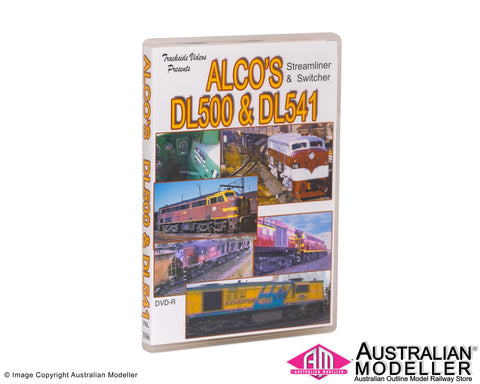Alco’s DL500 & DL541
In 1953 Alco introduced the DL500 design, its first model designed specifically for the export market. It was billed as the ‘World Locomotive’ and featured a FA-2 style nose cab with an extended body to support a range of different options and gauges. Power plant was the Alco 244D V12, a 1,600 HP diesel engine.
Because of a prolonged strike at Alco’s Schenectady plant, a single demonstrator was built by associate MLW (Montreal Locomotive Works) in Canada. After a slow start, orders started to flow in 1955 from Spain’s RENFE and North Western Railways of Pakistan. A.E. Goodwin became the Australian licensee in 1954, and its first local production was 6 single cab DL500Bs (930 Class) 1600 HP locomotives for the SAR (South Australian Railways). As it turned out, locomotive 930, delivered in late 1955, was the first locomotive in the world to be powered by a 251 V12 diesel engine. 31 further units with dual cabs followed over the following 10 years. All were at the delivered derate of 1600HP.
The NSWGR (New South Wales Government Railways) were rather impressed with the trials of the SAR locomotives leading to an order for 10 DL500C 1800HP 251 V12 (44 Class) locomotives in 1956, and after evaluating them against the Clyde-GM and Goninan-GE products, later extended it to 60 in 1959. After dabbling with 40 of the cheaper, less successful, hood equivalent (switcher) versions, the Alco DL541 1800HP 251 V12 (45 Class) which it ordered in 1961, NSWGR placed an order for a further 40 DL500Cs in 1964. With the changes and privatisation of the railways, the DL500s have passed to or been operated by many companies including Australian National, CFCLA (Chicago Freight Car Leasing Australia), Lachlan Valley, Independent Rail, HRVT (Hunter Valley Railway Trust), POTA (P & O Trans Australia), QUBE and SSR (Southern Shorthaul), but recently in 2014 the last was retired from commercial operation. Several remain active in the hands of railway heritage societies.
The 1960 introduction of the DL541 was inspired by the railways in Pakistan pushing for a switcher (hood) version of the DL500. NSWGR ordered 40 of the 45 Class in 1961 and the SAR followed up with 7 of their 600 Class in 1964. They were cheaper to build, but never favoured by crew because of the poor ride quality of the ‘trimount’ bogies, poor forward visibility because of the long front hood, the noise of the dynamic brake (which A.E. Goodwin decided to move from the original design at the rear of the locomotive to the short hood to provide better weight distribution as no steam generator was required by either NSWGR or SAR), and in NSW they invariably found themselves as second or ‘shaft’ units.
In 1988, 6 members of the 45 Class were upgraded to 35 Class in an endeavour to have them utilised as leading units, but without a great deal of success. In 1994, 4 of the 600 Class were converted to BU Class ‘slugs’ to be used in conjunction with ALF class locomotives on the heavy Leigh Creek coal and Broken Hill ore trains. Again following privatization and other changes on the railways, the DL541s have had service with Australian National, BHP (Broken Hill Proprietary), Engenco, Pacific National, Patrick PortLink and Silverton. All are now out of commercial service but a small number are operational for heritage operators.
Approximate run time: 102 minutes.

